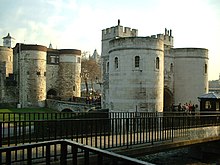Middle Tower

The Middle Tower is a tower-lined gate in the fortress of the Tower of London . The gate is at the southwest end of the tower on the city side of the moat. It is the first gate that visitors to the tower have to pass through today. A dam connects the Middle Tower with the Byward Tower , which was located in the fortress wall.
In front of the Middle Tower was the Lion Tower , which is no longer preserved. The tower was built in the 1280s on the orders of Edward I. built. It was created together with the outermost fortress ring. Like the similar but larger Byward Tower, the gate has two large, round outer towers that are connected to each other. At the back are smaller rectangular turrets that contain lounges.
In front of the Middle Tower are the remains of the drawbridge that formerly connected it to the Lion Tower. For example, the vaults on the first floor of the tower are originally medieval. These are made of brick , making them an early example of the use of this building material under Edward I.
Its current appearance dates back to the early 18th century when its facade was completely remodeled using Portland Stone . At that time, the Ordnance Barrack Master's living quarters were in the gate. The gate itself was in bad shape; In order to improve its statics, parts of the defenses were removed and the facade and internal parts were renewed. It is designed in the typical style of the Board of Ordnance . The design endeavored to have a medieval-martial appearance, but hardly went into detail on the historical building fabric.
The connection with the Byward Tower dates partly from the 13th century, partly it was renewed in the 18th century. Now as then, the dam has a slight bend in the middle, presumably to prevent a direct onslaught of attackers. Originally, walls with loopholes were built to the right and left of the dam, from which the trench could be fired at. Except for a remnant on the south side of the connection, these were removed in the 19th century.
Remarks
- ^ A b c Simon Bradley, Nikolaus Pevsner: London 1, The city of London , 1997, London: Penguin. ISBN 0-14-071092-2 , p. 360
- ^ A b Edward Impey and Geoffrey Parnell: The Tower of London. The official illustrated history , London: Merrell 2000, 128 pp., ISBN 1-85894-106-7 , p. 41
- ^ Edward Impey and Geoffrey Parnell: The Tower of London. The official illustrated history , London: Merrell 2000, 128 pp., ISBN 1-85894-106-7 , p. 84
Web links
Coordinates: 51 ° 30 ′ 28.6 " N , 0 ° 4 ′ 42.5" W.
